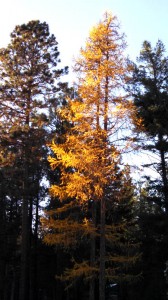Autumn in Western Montana is an exceptionally beautiful time of year with all the changing leaves in the valleys and river bottoms, but also in the higher mountains where the Larch (known by some here as Tamaracks) burst into a yellow-gold as their needles turn with the season and fall off, leaving a short-lived golden carpet.
As the Larch trees go through their yearly ritual of transformation, many newcomers make the mistake of thinking these trees, or portion of a forest, are dying (especially after they lose their needles). Scientifically what is happening is the needles, on these deciduous conifers, lose their chlorophyll which then reveals the yellow xanthophyll pigments, and then the needles drop to the ground.
In the winter the larch stands tall and stark, with bits of bear-hair lichen dangling from random branches. But a few weeks each spring, finds soft, new, bright pale green needles appearing; this makes it easy to distinguish the Larch tree from the rest of the forest.
The largest Western larch in the land is a giant, standing 153 feet near Seeley Lake. “I don’t think it has ever been aged precisely, but some estimates place it at 1,000 years,” said Andrew Larson, an assistant professor of ecology at the University of Montana.
Native American Indians could gather, carry and stack the Tamarack firewood without an ax or saw because even thick fallen tamarack branches were easily broken by hitting them on a stump or fallen tree. Natives also made wooden tamarack pots by hollowing out large pitchy burls. They used pitch to help heal cuts and bruises, and chewed it to ease sore throats. To relieve coughs and colds, they drank a tea made from the steeped bark. They made a sweet syrup by hollowing out part of the trunk and allowing moisture from the collected sap to evaporate, thus concentrating the thick liquid.
Bigfork holds its Tamarack Timber Festival in mid-October, and Seeley Lake’s Tamarack Festival runs the last week of September.

